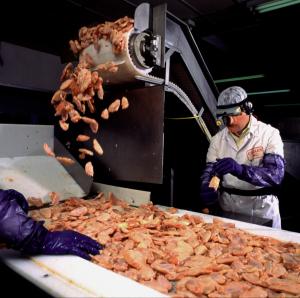ESPN2011 makes promising start with high attendance

More than 900 delegates have travelled to Cesme in Turkey to attend the 18th European Symposium on Poultry Nutrition, which started on Tuesday and is being hosted by the Turkish branch of the World Poultry Science Association.
On the first day five key note speakers informed the attendees of the latest developments in poultry nutrition. Robert Renema of the Poultry Research Centre of the University of Alberta, in Edmonton, Alberta, Canada discussed “Breeder nutrition and early growth traits of broiler chicks”.
The impact of maternal nutrition on broiler offspring quality, growth, immunity, and yield is a combination of long-term and short-term effects.
“Since nutrition in the broiler breeder growth and laying phases interact, and maternal nutrition can affect the broiler offspring, we can no longer afford to work in isolation along the broiler value-chain,” Renema said.
“To define practical nutritional solutions for optimal chick production, links between nutrition, reproduction, maternal nutrient transfer, and how they all change with hen age need to be better understood,” he concludes.
Early chick nutrition
Yael Noy of Miloubar Feedmill in Ashrat, Israel discussed the development in early nutrition of hatchlings.
When does the nutritional responsibility begin in the broiler industry? And what effect do the nutrients have immediately posthatch on further development. How critical is the nutrient composition during 0-3days post hatch on marketing parameters?
Just a few questions Noy tried to answer. She discussed neonatal imprinting and its significance on early nutrition.
Epi-genetics, or neonatal programming of gene expression by early nutritional imprinting can result in changes in genes with significant economic importance to the poultry industry. In other words: providing the right nutrients to a just hatched chick can have an impact on its performance later in production, because it triggers the right genes.
“The challenge now is how to combine early feeding and meeting of the unique nutritional needs of the young bird with the imprinting techniques that are available,” Noy concluded.
There seems to be a consensus regarding the advantages of early nutrition, however applying the concept under industry conditions is proving to be quite challenging.
Salmonella free feed
Richard Ducatelle of the Research group on Zoonoses and Veterinary Public Health of the
Faculty of Veterinary Medicine, Ghent University, in Merelbeke, Belgium presented an interesting lecture on “Egg and meat safety and feed approaches for the control of Salmonella”.
Eggs and poultry meat constitute important sources of non-typhoidal salmonellosis in people, but these Salmonella types rarely cause clinical disease in poultry.
“Thus control measures in live animals only aim at reducing shedding and carriage,” Ducatelle said.
A variety of feed additives have been tested for their suppressive effect on Salmonella shedding and carriage, mostly in broilers.
These include the classical probiotics, prebiotics, short- and medium chain fatty acids for which the beneficial effects usually are well documented.
Little information is available, however, on the newer experimental approaches, such as essential oils, changes in feed ingredients, bacteriophages or colonization-inhibition.
“All of these feed approaches deserve further investigation in order to develop an integrated control strategy which should guarantee an acceptable level of protection to the consumer,” Ducatelle ended.
Coccidiose vaccines
Joachim Brufau of Institut de Recerca i Tecnologia Agroalimentàries (IRTA) in Reus, Spain discussed the intercurrent Necrotic enteritis-coccidia process, which has become a complex problem in broiler production.
Coccidiostats are on the market since the 1940s, but many have disappeared again and only a few remained. Further developments in new products are not foreseen. Therefore vaccination is a method to keep the disease controllable.
“Under a vaccine anticoccidial program, without ionophores, feed composition and the use of enzymes are critical to keep performance and intestinal integrity,” Brufau concluded.
GMO in poultry nutrition
“Feed from genetically modified plants in poultry nutrition and future challenges” was the subject elaborated upon by Gerhard Flachowsky of the Institute of Animal Nutrition, Friedrich-Loeffler-Institute (FLI) in Braunschweig, Germany.
Flachowsky also has a presence in the European Feed Safety Authority (EFSA) and in that position generated several questions from the audience.
Regarding the strong competition for arable land between food/feed, fuel, fibre and further industrial materials high yielding plants with low external inputs should be the main aim of plant breeding, according to Flachowsky.
“Apart from traditional plant breeding plant biotechnology seems to have a certain potential to contribute to this objective,” he said.
“Safety and nutritional assessment of food/feed from GMP is urgently necessary. There exist strong guidelines for these assessments in many countries.”
Up to now most studies were done with GM-crops of the 1st generation (plants with input traits; without substantial changes in composition).
“No unintended effects in composition or contamination (except lower concentration of mycotoxins) and nutritional assessment of feeds from GM-crops of the 1st generation were registered in about 150 scientific studies with food producing animals,” Flachowsky said.
Most of the studies were done with rapidly grown chicks. Transgenic DNA and newly expressed proteins did not show other properties as plant DNA or endogenous plant proteins during feed treatment or in the animals.
Flachowsky: “Other experimental designs for nutritional and safety assessments are recommended for GM crops of the second generation – plants with output traits, with substantial changes in composition.”













